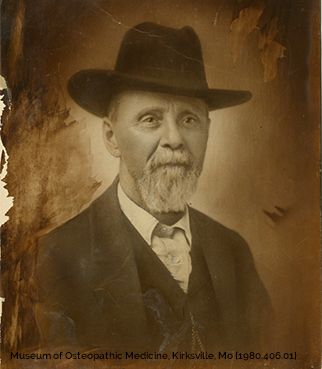Gründervater der Osteopathie
Gründervater der Osteopathie
Gründervater der Osteopathie
ist der amerikanische Arzt Dr. Andrew Taylor Still.
1874 verkündet Still seine neue Medizin und gibt ihr den Namen Osteopathie. Der zusammengesetzte Begriff leitet sich aus den altgriechischen Wörtern Osteo für Knochen und Pathie für Leiden her. Mit den Knochen hatte Still seine Studien begonnen, um die Leiden seiner Patienten lindern zu können.

Dr. Andrew Taylor Still
Andrew Taylor Still (1828 – 1917) hat bald mehr Patienten als er behandeln kann. So beschließt er Osteopathie zu unterrichten und gründet 1892 in Kirksville, Missouri, USA, die American School of Osteopathy (heute das Kirksville College of Osteopathic Medicine).
Seine Osteopathie findet großen Zuspruch. In der ersten Hälfte des 20. Jahrhunderts wird sie in immer mehr Bundesstaaten rechtlich anerkannt. Neue Colleges entstehen und bilden zunehmend mehr Studenten zu Osteopathen aus. Gleichzeitig gibt es massive Bestrebungen der Ärzteverbände die Osteopathie einzuschränken. Erst in den 1960er Jahren wird dieser Streit beigelegt. Seitdem gilt die Osteopathie in den USA als allgemein anerkannt.
Heute praktizieren etwa 54.000 Osteopathen in den USA ihren eigenständigen Beruf. Sie führen den Titel D.O., Doctor of Osteopathy, und sind Ärzten (Medical Doctors, MD) gleichgestellt. Daher verschreiben Osteopathen in den USA Medikamente, spritzen und führen Operationen durch. Die manuelle Diagnose und Behandlung des Patienten steht bei ihnen meist nicht im Vordergrund.
In Europa nimmt die Osteopathie eine andere Entwicklung. Ein Schüler von Still, der Engländer John Martin Littlejohn, bringt die Osteopathie nach Europa. In London gründet er 1917 die bis heute existierende British School of Osteopathy. Nach England erreicht die Osteopathie in den 1950er Jahren auch den Kontinent. In Europa sind es vor allem die Therapeuten, die in der Osteopathie einen neue wirksame Form der manuellen Therapie sehen. So entwickelt sich hier die Osteopathie als rein manuelle Form der Medizin weiter – ganz so, wie sie von A. T. Still, einmal begründet worden war.
Seit 1993 ist der Beruf des Osteopathen in England rechtlich anerkannt. In Belgien und Frankreich zählt die Osteopathie zu den allgemein anerkannten Formen der Medizin. Praktiziert wird die Osteopathie in nahezu allen europäischen Ländern.
Hatte sich Still vor allem mit dem Bewegungsapparat, also mit Knochen, Gelenken, Muskeln und Sehnen beschäftigt (parietaler Bereich), entwickeln andere Osteopathen das Konzept der Osteopathie fort.
Ein Schüler von Still, William Garner Sutherland (1873 – 1954), stellt 1939 das Phänomen der primären Respirationsbewegung vor. Dabei handelt es sich um eine sehr feine, eigenständig pulsierende Bewegung. Sie kann am Schädel, am Steißbein aber auch anderen Strukturen des Körpers erspürt werden und steht nicht im Zusammenhang mit Herzschlag oder Atmung. Die primäre Respirationsbewegung bildet fortan für Osteopathen ein wichtiges Instrument zur Diagnose und Therapie. Sutherland erweitert damit die Osteopathie um den so genannten craniosakralen Bereich.
Eine zusätzliche Ergänzung erfährt die Osteopathie in den 1980er Jahren. Die französischen Osteopathen Jean-Pierre Barral und Jacques Weischenck beschäftigen sich ausführlich mit den inneren Organen und wie diese osteopathisch untersucht und behandelt werden können. Sie greifen dabei u.a. auf die Techniken und Erkenntnisse des schwedischen Gymnasten Thure Brandt (1819 – 1895) und seines Schülers Henri Stapfer auf und erweitern die Osteopathie um den so genannten viszeralen Bereich.
KONTAKTINFORMATION
Praxis für Osteopathie ÖFFNUNGSZEITEN
| Montag | 08:00 – 20:00 |
| Dienstag | 10:00 – 20:30 |
| Mittwoch | 9:00 – 20:00 |
| Donnerstag | 10:00 – 21:00 |
| Freitag | 14:00 – 20:00 |
| Samstag | 12:00 – 18:00 |